Abstract
The Palestinian environment suffered from abuse and neglect for decades. As a nascent state, Palestine aspired to protect and restore its environment, in line with international standards and conventions. Yet, many challenges remain, including a lack of data, the science–policy–practice gaps, and the lack of sovereignty. The management of protected areas (PAs) is particularly challenging under these circumstance. Two key protected areas in the northern West Bank (Wadi Qana and Wadi Al-Zarqa Al-Ulwi) were surveyed, with a focus on plant communities and dealing with threats. The two areas had similar Mediterranean flora with differences, including in rare plants. Both areas have important but different wetlands in their buffer zones. The data show that the protection of the two areas is important because of the differences noted, and both areas are valued as IUCN category IV (habitat/species management area) protection. Such protection is possible by working with local communities and bridging the science–policy–practice gaps.
1. Introduction
Palestine connects Africa with Eurasia and is in the western part of the Fertile Crescent, where the first humans migrated out of Africa and agriculture first developed [1,2]. The rich biodiversity in a small area here is due to geology (formation of the Great Rift Valley) and geography (land corridor between Eurasia and Africa). Five phytogeographical zones are recognized in a land of 27,000 km2: Mediterranean, Irano-Turanian, Coastal, Saharo-Arabian, and Ethiopian-Sudanese. Few studies of biodiversity in the Palestinian Territories (PT) have been conducted compared to the nearby areas of historic Palestine and Jordan. The Eastern Mediterranean region has been sporadically studied before by visitors to the “Holy land”, starting with Tristram’s monumental work [3]. Most studies on the flora were conducted inside the areas of Palestine that became Israel in 1948 [4,5,6,7,8,9], and only recently have data started to come out from the West Bank, which was occupied in 1967 [10,11,12,13,14]. Yet, much work needs to be done, especially in protected areas [15,16,17,18,19,20]. The work is particularly needed because the Palestinian environment is part of the Mediterranean hotspot of biodiversity [21] and has experienced declines in biodiversity due to anthropogenic factors [19,22,23,24,25].
Many of the “protected areas” in the West Bank are believed to have been designated by the Israeli authorities for ideological reasons [15,18,19,26]. These “protected areas” in the West Bank were recently evaluated by a professional team consisting of the IUCN, our Palestine Institute for Biodiversity and Sustainability, and the Palestinian Environment Quality Authority. The results (to be published in 2023) eliminated 22 areas, added some, and consolidated others to produce a list of 26 areas in the West Bank and 1 in Gaza. The new protected area network covers key biodiversity hotspots and all phytogeographic zones and protects most threatened and endangered species (fauna and flora). Only five of the protected areas have management plans based on limited data. Research is needed on the flora of all 27 areas. Only one area (Wadi Al-Quff) had its flora [10] and its management plan [20] published in peer-reviewed journal. Another area, Al-Arqoub, has a paper submitted [25]. Both areas are in the southern region of the West Bank. We selected two protected areas in the north for detailed study to provide a basis of knowledge for conservation efforts: Wadi Qana (WQ) and Wadi Ein Al-Zarqa Al-Ulwi (WZ). Both areas were considered important before and after the new validation study. Both valleys have an interesting assemblage of geologic formations that also include evidence of early human habitation [27]. Wadi Natuf, just 6 km to the South-West of WZ, had evidence of the earliest human agriculture, now commonly called the Natufian period [28,29]. We were intrigued by the potential differences and lessons from the two areas, including threat susceptibility and mitigation. Useful lessons may be learnt from the data presented for plant conservation in vulnerable areas of the Mediterranean basin.
2. Materials and Methods
The study areas of Wadi Qana (WQ) and Wadi Ein Al-Zarqa Al-Ulwi (or, simply, Wadi Zarqa) (WZ) are two valleys in the central highlands of Palestine (northern part of the West Bank). Their elevations are similar, with the west-to-east elevational level above the sea level inside the west bank going from about 120 m to 450 m for WZ and from 240 to 700 m for WQ. Both are about 20 km long and lie within rugged mountains and deep valleys, which expose mostly Cenomanian geologic formations. The average minimum temperature ranges from 8 to 12 °C during winter, and the average maximum temperature ranges from 22 to 28 °C in summer. Both receive an average annual rainfall of 600–700 mm (depending on the location within the two areas) and have mild winters and hot and dry summers.
The two valleys were designated as protected areas by the Environment Quality Authority as part of the new 2022 protected area network (Figure 1). WQ is 15.32 km2, while WZ is 13.22 km2. Both are fed by natural springs (seven each in WQ and WZ). Together, the two areas are in the midst of over 55 Palestinian communities and 15 Israeli settlements [30,31]. WZ is surrounded by seven villages: Deir Ballout, Kufr al-Deek, Brouqin, Deir Ghasana, Beit Rima, Abud, and Rantis. WQ also has several Palestinian villages around it, including Deir Istya, Jinsafut, and Al-Funduq. Since the start of the baseline survey in 2017, we worked with local communities for both data gathering and analysis, and we started programs of the dissemination of the results (e.g., in schools and community centers). Plant species occurrence and biodiversity monitoring was carried out mostly in the spring seasons of 2017–2020 using standard techniques [32,33]. Briefly, this was primarily a qualitative assessment of the presence or absence of species by walking the park in linear transects that covered the different habitat types in each protected area. The threat analysis was informed by the classification scheme provided by IUCN [34] and by discussion with locals. Locals were also involved in shaping recommendations and action plans for the areas (presented at the end of the discussion).
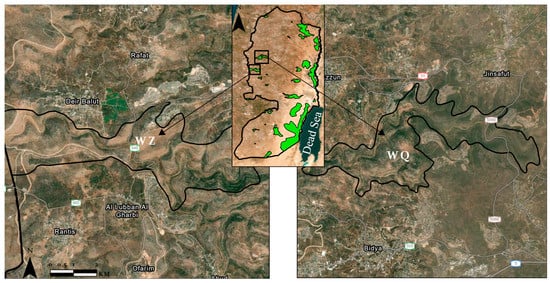
Figure 1.
Map of Wadi Al-Zarqa (WZ, left) and Wadi Qana (WQ, right) and their position inside the West Bank with other protected areas (middle, protected areas in green).
3. Results
WQ contains five freshwater springs draining via tributaries to the West. Its habitat is characterized by mixed Mediterranean forests, with primarily maquis types, Terra Rosa soil, and trees such as Phillyrea latifolia, Ceratonia siliqua, Pinus halepensis, Pistacia lentiscus, Pistacia palaestina, Quercus caliprinos, and Rhamnus palaestinus (Figure 2). Near the valley, there is a vernal pool called Uskar next to the village of Jinsafut, with unusual plants not found elsewhere in the West Bank, including: Glinus lotoides, Ranunculus peltatus, Eleocharis palustris, Cryosis factorovskyi, Arum hygrophilum, and Carex pachystylis. The area has at least six Palestinian communities and nine Israeli settlements.
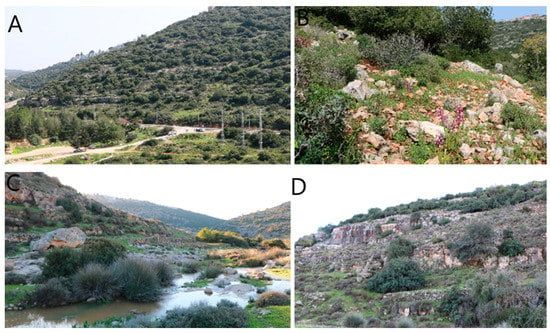
Figure 2.
Floral habitats of Wadi Qana. (A): Entrance of the valley from the main road shows a hill with typical Mediterranean undisturbed oak forest and, below it, pine trees at the road intersection; (B): Batha and Garigue areas; (C): near one of the springs in the valley with Juncus and other hydrophilic plants; (D): cliff side with natural areas and olive cultivation in the valley.
In the survey, we noted WZ to have seven springs inside the protected area and a few nearby. The area covers diverse habitats including urban areas, natural forests, cultivated fields, and rocky outcrops. Wadi Al-Zarqa is within in the Mediterranean zone. This zone represents most of the Palestinian Territory, extending from Hebron across Jerusalem and north to Jenin. The soil type is dominated by terra rossa and pale rendzinas with patches of grumusols, brown and pale rendzinas, and solonchalks. The forests within this area include Arbutus andrachne, Ceratonia siliqua, Pistacia lentiscus, Pistacia palaestina, Quercus, caliprinos, and Rhamnus palaestinus, with shrubs including Sarcopoterium spinosum. Like WQ, WZ has six Palestinian communities but fewer Israeli settlements (five instead of nine) in its surrounding areas.
The Wadi Al-Zarqa system includes the western part that extends along the boundaries of Deir Ballout to the extreme west, reaching the Separation wall (the wall that Israel is building inside the West Bank, which already affects biodiversity). In general, the northern edges of this area are more rocky than the southern edge, including Rhamnus palaestinus. To the most western side, close to the separation wall, R. palaetisnus becomes denser and healthier (Figure 3). The separation wall surrounds the wadi system from the west and the south. The eastern part of the wadi is more densely vegetated by a secondary growth of evergreen oak, Quercus calliprinos, mixed Pistacia lentiscus and Pistacia palaestina, few stands of Carob, Cer-atonia siliqua, and relatively obvious but scattered Crataegus aronia and Rhamnus palaetisna. The plains and slopes of the wadi are cultivated with olive trees. The middle part of this section supports the dense vegetation around its natural drainage due to the formation of pools filled with sewage water. A significant biodiversity-rich area was found in the eastern edge of Deir Ballout (transition zone of WZ), where we noted the vernal area that is inundated roughly from January to early April and then cultivated by the local farmers. It harbors the unique crustaceans Lepidurus apus and Triops cancriformis, a food source for local amphibians and migrating birds. Rare plants in this vernal area include Cyperus longus, Medicago scutellata, and Lupinus pilosus.
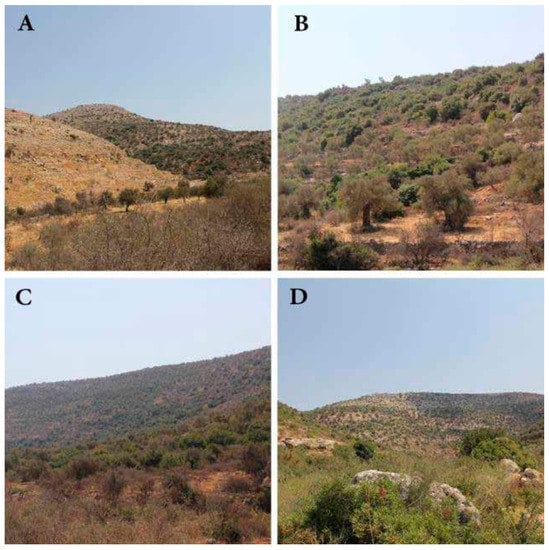
Figure 3.
Habitats in WZ: (A): Olives in the valley with different coverages of vegetation on two sides of the valley; (B,C): Typical Mediterranean habitats of oaks, carobs, and hawthorn on the less accessible hills, but human cultivation of trees in the valley; (D): Less dense Garigue vegetation in the western part of valley and hillside (mostly shrubs).
Comparisons
We recorded 257 plants in Wadi Zarqa and 253 species in Wadi Qana. Among the trees, we noted that WQ characteristically has Phillyrea latifolia, while WZ has Arbutus andrachne. The results are interesting, regardless of nomenclature; we have identified some problems with the systematics (nomenclature) of orchids in this study and have embarked on a project to revise it (a master’s student is working on, among other things, using DNA phylogeny analysis). The total number of rare plants between the two areas is 48 species of rare (many endangered; see below) plants found in these two protected areas. There are 21 rare species in WZ but not in WQ and 15 in WQ but not in WZ, and the rest (12) are found in both places (Table 1). The list excludes plants found in buffer zones of the two areas (see below).

Table 1.
Rare Plants in Wadi Qana and Wadi Zarqa shows both similarities and differences in floral composition lf important plants. Status abbreviation: O = Extremely Rare with 1–3 sites in the West Bank, RR = Very Rare (4–10 sites in the West Bank), R = Rare (11–30 sites). In bold, we show hygrophyl (wet-dependent) plants, but these exclude the vernal pools discussed below.
The list is of species in the actual protected areas. However, there are buffer zones near both WZ and WQ that are of interest. Temporary vernal ponds (referred to in Arabic by the term “Balu”) are found in both areas, but with very different species compositions due to the differences in the length of time during which water remains and the fact that the Uskar pond near WQ is basic (pH = 8.5–8.6), as it sits on karstic soils. The Uskar pool near WQ (Figure 4) is basic (pH = 8.5–8.7) and lasts until summer (June and even into July), and it has unique plants. Most of them were not seen elsewhere in our surveys in the West Bank and were not found in the core zone of the protected area: Ranunculus peltatus. Lemna gibba, Eleocharis palustris, Crypsis factorovskyi, Trifolium fragiferum, Arum hygrophilum, and Glinus lotoides [17]. The plain of Deir Ballut is far larger (about 600–700 m in width compared to Uskar, which is only 12–15 m in width) and retains water for much shorter periods (until April at the latest) because it sits on Terra Rosa soils. The latter, while less unique in our region than the vernal pool in the WQ buffer zone, was noted to have at least two species of crustaceans that are of conservation interest and are being studied now.
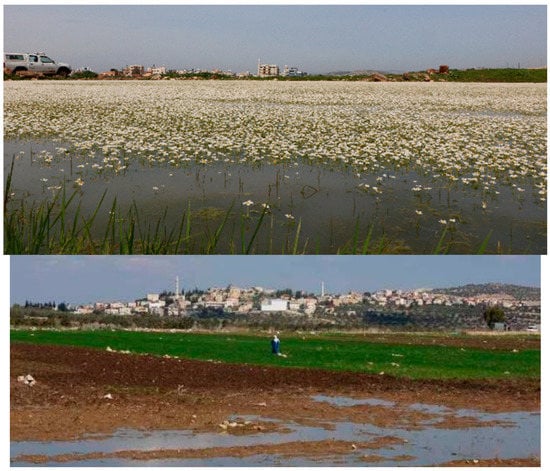
Figure 4.
Temporary rain ponds in the buffer zones of the two protected areas. (Top), in Jinsafut near Wadi Qana, with the flowering rare plant Ranunculus peltatus, and (Bottom), in Deir Ballout near Wadi Zarqa, which has interesting crustaceans.
Overall, the collected data on plants showed a richer biodiversity in WZ than in WQ, both for total plant species and for rare plants, as noted above. Besides biodiversity, a recent study we conducted, scoring a number of characteristics including vegetation cover, potential for protection, threats, local engagement, management potential, and others, showed the score for WZ to be higher than that for WQ (41 versus 35; PIBS/EQA/IUCN unpublished data). Regarding other practical data, we note that the Deir Ghassaneh and Kufer Al Deek villagers used many plants in WZ for medicinal purposes, such as Salvia fruticosa, Salvia hierosolymitana, Thymbra spicata, and Saturja thymbra (Figure 5). They are most often found in very steep areas, where it is very difficult for people to go to harvest these species. Generally speaking, the area constitutes a reservoir of medicinal plants and spices for Ramallah.
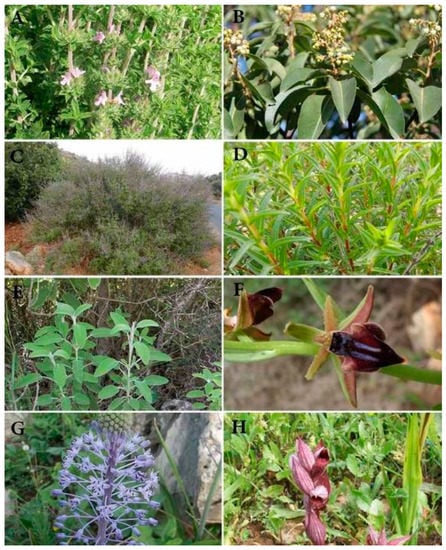
Figure 5.
Selected plants in WZ. (A). Satuja thymbra. (B). Arbutus andrachne. (C). Vitex agnuscastus. (D). Thymbra spicata. (E). Salvia fruticose. (F). Ophrys cf. adonidis. (G). Scilla hyacinthoides. (H). Serapias vomeracea.
4. Discussion
According to Garstecki et al. [15], both areas were classified as IUCN Category IV (Managed Reserve). Most of the land ownership is private. We worked with five local municipalities around WZ (Deir Ballout, Brouqin, Kufr Deik, Deir Ghassaneh, and Salfit), two around Wadi Qana (Jiftlik and Al-Funduq), the Ministry of Education, the Environmental Quality Authority, and the Governorate of Salfit from the beginning of this project. The local communities helped with logistics, educational workshops, and gathering the needed data (on species, habitats, and threats). For example, the process educated over 800 students and community members about environmental conservation issues, the value of nature (ecosystem services), and the potential of ecotourism.
The Environment Quality Authority (EQA), the IUCN, and our institute recently engaged in a process of creating and validating the protected area network in the West Bank and developed 13 criteria consistent with the IUCN criteria [35]. Both areas scored high. Such reserves should be “managed” in ways that help bring out ecosystem services for the benefit of the local communities while dealing with the threats (see below). The support of the local people (served communities) is key to success. The locals were more cooperative than we expected. They were generous with their time and resources, but more importantly, they wanted to learn what is surrounding them and how to manage these rich natural resources that they learned about via the workshops.
Modern conservation philosophy argues that the local buy-in is critical for the success of conservation efforts, and this is also the case in Palestine [24]. The Sixth National Report to the Convention on Biological Diversity [19] and the work now being completed on the National Biodiversity Strategy and Action Plan both emphasized the importance of studies like this one; indeed, the findings, modest as they are, bolster the need for many more studies in light of the threats we (like other developing countries) face, ranging from climate change to pollution to habitat destruction.
The above-mentioned results on plants are fascinating in several ways. First, it is notable that two areas with Mediterranean habitats show different mixtures of plant habitats and, especially, a notable difference in the presence of rare species (Table 1). The fauna are not addressed here, as our focus was plants. Both areas also had vernal pools in their buffer zones, but these two vernal pools differed greatly in terms of flora and (while limited) observations on fauna (e.g., there is no Pelobates syriacus in the WZ vernal pool). The data thus justify the protection of both areas, even though they both have Mediterranean zone flora and are near each other. Further bolstering the need for conservation is the fact that both have significant threats. Here, we summarize those threats:
Urbanization: Originally, both study areas were surrounded by several small villages where natural caves were used to keep animals. Now, these villages are expanding, and animal sheds have been constructed on ledges around the wadi area, reaching the periphery of the core area of both WQ and WZ (Figure 6). This will certainly affect bats that take refuge in the caves.

Figure 6.
Animal sheds and the use of natural caves for animal keeping in WZ.
Overgrazing: We observed many herds of sheep and goats grazing within the lowlands of both study sites. Goats can climb and feed on trees and shrubs (Figure 7), while sheep feed on annual plants and grasses. The grazing period occurs from March to November, with animals switching from green to dry plant material in May. Thus, this will affect seed formation if grazing is not managed.
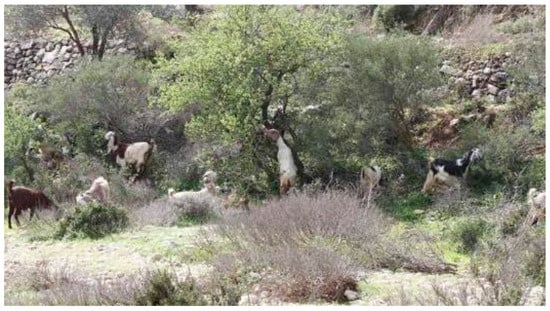
Figure 7.
Overgrazing goats in Wadi Al-Zarqa.
Solid and liquid waste: There have been studies that show that human sewage from both Israeli settlements and Palestinian communities pollutes the waters and the land of Wadi Qana [30] and Wadi Zarqa [36]. Household garbage that consists mostly of plastic (plastic bags and bottles), metal cans, and food remains was also noted (Figure 8). These materials are sometimes burned on site, forming fumes and fire in the wooded areas.
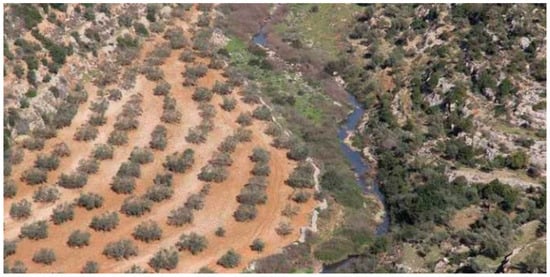
Figure 8.
Flow of untreated sewage in part of the WZ PA. The picture also shows olive trees planted in the valley and small remaining natural areas on the steeper hills.
Culling of Natural Resources: It seems that wood cutting is a major threat that affects the vegetation cover in both areas, especially the western sections. This is mainly due to the traditional limestone manufacturing process for building houses and painting. Large numbers of trees were cut to fuel piles of stones. Wood cutting was practiced on a large scale as fuel for heating and other household activities by the surrounding counties. On the other hand, the western areas still have dense vegetation, with limited cutting but more overgrazing. The locals cut trees for domestic use (heating and cooking) in many villages around the area, perhaps due to the high price of fuel. Hunting is practiced on a large scale by the locals. The porcupine, rock hyrax, and mountain gazelle are the main targeted species. Porcupines are hunted using dogs, and their meat is consumed on the belief that it can cure asthma and other respiratory illnesses. The lack of an implementation of Palestinian laws protecting wildlife is likely to play an important role in the loss of large mammals and certain birds. Birds such as chuckar, black bird, and blackcap are hunted for their meat, while the European Serin and the siskin are trapped for cage keeping.
Invasive species: Both valleys had some invasive plants. In Wadi Qana, these included Ambrosia confertiflora, Conyza bonariansis, and Oxalis pes-caprae. In Wadi Zarqa, these included Oxalis pes-caprae. On the periphery of Wadi Qana and Wadi Zarqa, associated with human habitations, we observed the invasive Myna bird Acridotheres tristis [37]. We also noted wildboar populations expanding and in some cases damaging some areas, such as the Uskar vernal pool, with endangered plant and animal life.
Israeli activities: Israel constructed a segregation wall in 2002. Deir Ballout is one of the most negatively impacted Palestinian towns in terms of the direct loss of land behind the wall (8000 donums; a donum is 1000 sq km), the loss of agricultural wealth and water resources, and the impact on the environment. Because all of the confiscated land behind the wall had previously been used for grazing and growing winter crops, many pastoralists were forced to seek out other parts of the wadi, leading to overgrazing and a decline in natural vegetation cover. Other large- and medium-sized animals, such as the badger, are also prevented from moving freely across the WZ system. The Mountain Gazelle was observed on the western side; however, it cannot move freely across the natural flow of the wadi system (Figure 9). Other large- and medium-sized animals such as the badger are also denied free movement across the WZ system [38].
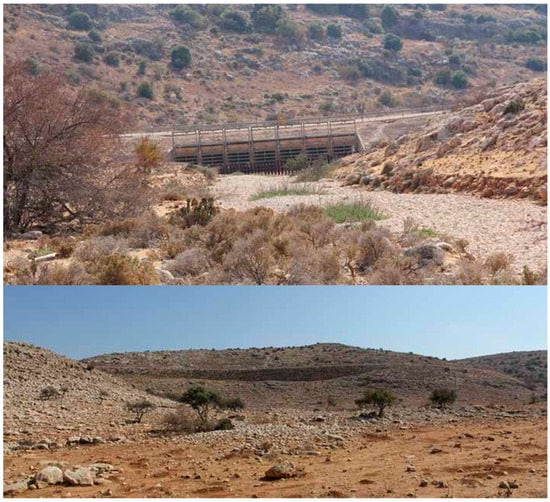
Figure 9.
Segregation wall on the western part of WZ limiting the free movement of large animals on both sides.
Noise pollution: WZ is located in close proximity to an airport, with various airplanes descending or taking off at low altitudes, casing noise pollution.
The key vision that drives, or should drive, environmental conservation in Palestine, and elsewhere, should be a vision of a sustainable human population in a sustainable, diverse natural environment. Two key factors that contribute to the success of environmental conservation in any country are economic and social factors, and both are limited in Palestine [18]. The level of GDP is directly correlated with environmental concerns [39]. The 14 million Palestinians in the world are now dispersed in many countries, with almost 8 million being refugees or displaced people. The GDP of the remaining Palestinians is 1/8th of that of Israelis, who share with them the space of historic Palestine, but this gets more distorted during the cyclical uprisings against the occupation [40]. There was a decline in GDP growth in the past few years as the population grew while the economy did not expand [41]. However, as noted above, much can be and is being done, even under such limiting circumstances. Much more can also be done.
5. Recommendations
The recommendations below are based on: (A) the result of the scientific (technical) study, especially of the flora (but with some input from our unpublished faunal studies); (B) workshops held with local and national officials and concerned stakeholders; (C) individual meetings with key knowledgeable people and feedback from other scientists; (D) an SWOT (Strengths, Weaknesses, Opportunities, Threats) analysis. They were agreed upon in workshops related to the two areas, which were held with the involved communities and form the basis of long-term monitoring and evaluation by local authorities under the supervision of the Environmental Quality Authority.
Reduce and recycle liquid waste: Programs for reducing and reusing (after treatment) liquid waste should be implemented. Liquid waste treatment facilities can be built near the agricultural areas and the treated water used for trees.
Reduce, Reuse, and Recycle solid waste: Village and municipal councils must enforce existing laws of collection but can also develop new projects such as separating organic waste (currently over 50% of waste) and composting it to produce organic natural fertilizers for the farmers.
Develop sustainable local economies linked to environmental conservation (ecosystem services): Ecotourism can be developed to benefit locals and help raise awareness. However, this needs to be well structured, and paths need to be designated and marked by experts. The work we carried out can provide baseline data.
Encourage further scientific research: Encourage further research on habitats and species composition, including studies of temporal changes that will guide conservation efforts.
Environmental education and awareness: More workshops need to be held so that the locals, students, and stakeholders stay informed and act regarding environmental protection. Environmental clubs at schools need to be nurtured and supported.
Strict laws and their enforcement: The EQA is in the process of formulating new laws for the parliament to approve to supplement the Palestinian Environmental Law of 1999. These laws need to be strictly enforced.
Environmental justice: This is now considered an essential aspect to include in areas of conflict zones, and it certainly helps to include the environment in peace-building efforts.
Manage and protect endangered species and habitats: Implement a well-designed management plan for each of these protected areas. There are certain critically endangered species that can be saved with better study and management. Examples include some of the rare plants listed in Table 1, as well as animals such as bats, Syrian spade-footed toads (Pelobates syriacus) [17], tree frogs (Hyla savignyi group), and large mammals.
Better rural and urban design: There need to be master plans for the villages around the protected area and for the municipality of Salfit that take into account environmental issues, including not encroaching on the protected areas (which is happening now). There needs to be enforcement of these issues, such as preventing the random opening of agricultural and other roads that fragment habitats and impact the two valley systems.
Study and protect transitional/buffer key areas: This project was focused on the protected areas themselves, with some attention given to vernal ponds near the areas (in buffer zones). Much more work is needed in these zones at the margins of protected areas, which can be critical in management [17,42,43,44].
Developing ecosystem services: The work provides baseline data that can be used in promoting the benefits of nature to people, such as ecotourism [45] and other ecosystem services that promote community well-being while conserving nature. There are guidelines for such work [46], and some studies like this were conducted—for example, in Iran [47,48].
6. Conclusions
The data show significant differences between the two protected areas in terms of habitats, buffer zones, and the list of rare plants, but they show similarities in terms of threats. This is despite the closeness in terms of geography, climate, and topography. The recommendations for protections were developed, but many need implementing. The data do give a baseline, which can be measured over time to ensure the conservation of both nature and local communities. The limitations of the data are that they focus on comparisons of the two areas over a short period, and while assessing and attempting to deal with threats, they did not produce detailed management plans (which are still needed). Further studies are required to obtain a deeper understanding and mapping of the flora and fauna in the two areas as well as the changes in habitats due to anthropogenic effects.
Author Contributions
Conceptualization, M.B.Q.; methodology and data collection, B.A.-S. and M.B.Q.; result analysis, B.A.-S. and M.B.Q.; funding acquisition, M.B.Q.; writing, B.A.-S. and M.B.Q. All authors have read and agreed to the published version of the manuscript.
Funding
This project was performed with funding from the Global Environment Facility/Small Grants Program (UNDP/GEF/SGP fund number PAL/SGP/OP6/Y2/CORE/16/01) and the EUPI project “Unity and Diversity in Nature and Society” (fund number ENI/2019/162124/83) and internal funding from the Palestine Institute for Biodiversity and Sustainability (PIBS) and the Palestine Museum of Natural History (PMNH) at Bethlehem University (BU).
Institutional Review Board Statement
The study was conducted in accordance with the Declaration of Helsinki, and approved by the Institutional Review Board of Bethlehem University via Initial Memo Form for GEF dated 20 January 2017.
Data Availability Statement
Data supporting this project is found at http://almakhrour.palestinenature.org, accessed on 29 November 2022.
Acknowledgments
We thank the Environmental Quality Authority (EQA), Zuhair Amr, Elias Handal, Mohammad Najajreh, Mohammed Abusarhan, Mubarak Zawahra, and the local communities that helped, including Mohammed Sheabi and Basem Mousa. We also thank three anonymous reviewers whose input significantly improved the final draft.
Conflicts of Interest
The authors declare no conflict of interest.
References
- Munro:, N.D.; Grosman, L.; Yasur-Landau, A.; Cline, E.H.; Rowan, Y. The forager–farmer transition in the southern Levant (ca. 20,000–8500 cal. BP). In The Social Archaeology of the Levant: From Prehistory to the Present; Cambridge University Press: Cambridge, UK, 2018; pp. 47–65. [Google Scholar]
- Preece, C.; Livarda, A.; Christin, P.A.; Wallace, M.; Martin, G.; Charles, M.; Jones, G.; Rees, M.; Osborne, C.P. How did the domestication of Fertile Crescent grain crops increase their yields? Funct. Ecol. 2017, 31, 387–397. [Google Scholar] [CrossRef] [PubMed]
- Tristram, H.B. The Survey of Western Palestine: The Fauna and Flora of Palestine; Adelphi, for the Committee of the Palestine Exploration Fund: London, UK, 1885. [Google Scholar]
- Zohary, M. Flora Palaestina; The Israel Academy of Sciences and Humanities: Jerusalem, Israel, 1966; Volume 1. [Google Scholar]
- Zohary, M. Flora Palaestina; The Israel Academy of Sciences and Humanities: Jerusalem, Israel, 1972; Volume 2. [Google Scholar]
- Feinbrun-Dothan, N. Flora Palaestina; The Israel Academy of Sciences and Humanities: Jerusalem, Israel, 1978; Volume 3. [Google Scholar]
- Feinburn-Dothan, N. Flora Palaestina; The Israel Academy of Sciences and Humanities: Jerusalem, Israel, 1986; Volume 4. [Google Scholar]
- Danin, A. Flora and vegetation of Israel and adjacent areas. In The Zoogeography of Israel; Tom-Tov, Y., Tchemov, E., Eds.; Dr. W. Junk Publishers: Dordrecht, The Netherlands, 1988; pp. 129–158. [Google Scholar]
- Danin, A. Distribution Atlas of Plants in the Flora Palaestina Area; The Israel Academy of Sciences and Humanities: Jerusalem, Israel, 2004. [Google Scholar]
- Al Sheikh, B.; Mahassneh, M. Flora of Wadi Al-Quff Protected Area, Hebron Governorate, Palestine. Jordan J. Nat. Hist. 2016, 1, 47–57. [Google Scholar]
- Al-Sheikh, B. Checklist and Ecological Database of Plants of the West Bank-Palestine; National Agricultural Research Center: Jenin, Palestine, 2019.
- Pahl, J.; Qumsiyeh, M.B. Orchids of the Occupied Palestinian Territories (West Bank, Palestine). Mediterr. Bot. 2021, 42, e72120. [Google Scholar] [CrossRef]
- Al-Sheikh, B.; Qumsiyeh, M.B. Imperiled ecosystems in Palestine: Rare plants as Indicators. In Dominic DiPaolo & John Villella Imperiled: The Encyclopedia of Conservation”, Reference Module in Earth Systems and Environmental Sciences; Elsevier: Amsterdam, The Netherlands, 2021; pp. 1–7. [Google Scholar]
- Al-Sheikh, B.; Qumsiyeh, M.B. New Records to the Flora of the West Bank, Occupied Palestinian Territories. Jordan J. Nat. Hist. 2021, 8, 11–19. [Google Scholar]
- Garstecki, T.; Al-Rabi, T.; Mahassneh, M.; Mezyed, B. Assessment of Some Palestinian Nature Reserves; International Union for Conservation of Nature: Gland, Switzerland, 2010.
- Qumsiyeh, M.B.; Amr, Z.S. Protected Areas in the Occupied Palestine Territories. Jordan J. Nat. Hist. 2016, 1, 25–46. [Google Scholar]
- Qumsiyeh, M.B.; Handal, E.N.; Al Shaikh, B.; Najajreh, M.H.; Albaradeiya, I.M. Designating the first vernal pool microreserve in a buffer zone of Wadi Qana protected area, Palestine. Wetlands 2022, 42, 119. [Google Scholar] [CrossRef]
- Qumsiyeh, M.B.; Albardeiya, I.M. Politics, Power, and the Environment in Palestine. Afr. Stud. 2022, 37, 9–18. [Google Scholar]
- EQA. Sixth National Report To The Convention On Biological Diversity. 2021. Available online: https://chm.cbd.int/database/record?documentID=257520 (accessed on 11 January 2023).
- Qumsiyeh, M.; Khalilieh, A.; Albaradeiya, I.M.; Al-Shaikh, B. Biodiversity Conservation Of Wadi Al-Quff Protected Area: Challenges And Opportunities. Jordan J. Nat. Hist. 2016, 1, 6–24. [Google Scholar]
- Salmerón-Sánchez, E.; Mendoza-Fernández, A.J.; Lorite, J.; Mota, J.F.; Peñas, J. Plant conservation in Mediterranean-type ecosystems. Mediterr. Bot. 2021, 42, e71333. [Google Scholar] [CrossRef]
- UNEP. Desk Study On The Environment in the Occupied Palestinian Territories. 2003. Available online: https://wedocs.unep.org/20.500.11822/7854 (accessed on 11 January 2023).
- Qumsiyeh, M.B.; Zavala, S.; Amr, Z. Decline in Vertebrate biodiversity in Bethlehem, Palestine. Jordan J. Bio. Sci. 2014, 7, 101–107. [Google Scholar] [CrossRef]
- Qumsiyeh, M.B.; Abusarhan, M. Biodiversity and Environmental Conservation in Palestine. In Biodiversity Conservation and Sustainability in Asia; Öztürk, M., Altay, V., Efe, R., Eds.; Prospects and Challenges in West Asia and Caucasus; Springer Nature: Cham, Switzerland, 2021; Volume 1, pp. 1–22. [Google Scholar]
- Qumsiyeh, M.B.; Bassous-Ghattas, R.; Handal, E.N.; Abusarhan, M.; Najajreh, M. Threats and conservation strategy for a UNESCO World Heritage Site in Areas of Conflict: Case study in Al-Arqoub, Palestine. Park. J. 2022. submitted. [Google Scholar]
- Qumsiyeh, M.B.; Amr, Z.S. Environmental Conservation and Protected Areas in Palestine: Challenges and Opportunities; HSS (Hans Seidel Foundation): Munich, Germany, 2017; Available online: https://www.mahmiyat.ps/uploads/171013%20HSF_Bethlehem_Printed%20Version_NC.pdf (accessed on 11 January 2023).
- Agam, A. Late lower paleolithic lithic procurement and exploitation strategies: A view from Acheulo-Yabrudian Qesem Cave (Israel). J. Arch. Sci. 2020, 33, 102447. [Google Scholar] [CrossRef]
- Garrod, D.A.E. Excavation of a Palaeolithic cave in western Judaea. Quarterly Statement of the Palestine Exploration Fund. Palest. Explor. Q. 1928, 60, 182–185. [Google Scholar] [CrossRef]
- Callander, J. Dorothy Garrod’s excavations in the Late Mousterian of Shukbah Cave in Palestine reconsidered. Proc. Prehist. Soc. 2004, 70, 207–231. [Google Scholar] [CrossRef]
- Naser, S.; Ghanem, M. Environmental and Socio-Economic Impact of Wastewater in Wadi-Qana Drainage Basin-Salfeet-Palestine. J Geogr. Res. 2018, 1, 1–6. [Google Scholar] [CrossRef]
- PMNH (Palestine Museum of Natural History). Actions for Environmental Sustainability in Wadi Al-Zarqa Al-Ulwi; Bethlehem University: Bethlehem, Palestine, 2018; Available online: https://www.palestinenature.org/conservation/WadiZarqaTechnical.pdf (accessed on 11 January 2023).
- Hill, D. (Ed.) Handbook of Biodiversity Methods: Survey, Evaluation and Monitoring; Cambridge University Press: Cambridge, UK, 2005. [Google Scholar]
- Ansari, A.A.; Sarvajeet, S.G.; Abbas, Z.K.; Naeem, M. (Eds.) Plant Biodiversity: Monitoring, Assessment and Conservation; CABI: Oxfordshire, UK; Boston, MA, USA, 2017. [Google Scholar]
- IUCN. Threats Classification Scheme (Version 3.3). 2022. Available online: https://www.iucnredlist.org/resources/threat-classification-scheme (accessed on 11 January 2023).
- Dudley, N.; Phillips, A. Forests and Protected Areas: Guidance on the Use of the IUCN Protected Area Management Categories; IUCN: Gland, Switzerland, 2006; Volume 34.
- Abu Alan, K.; Ghanem, M. Environmental study of spring water quality in the Zarqa Natural Reserve-West Ramallah/Palestine. Rev. Microbiol. Ind. San. Et Environn. 2014, 8, 208–220. [Google Scholar]
- Handal, E.; Qumsiyeh, M.B. Status and Distribution of the invasive Myna Acridotheres tristis (Linnaeus, 1766) in the Occupied Palestinian Territories (West Bank). Sandgrouse 2021, 43, 129–132. [Google Scholar]
- Husein, D.; Qumsiyeh, M.B. Impact of Israeli segregation and annexation wall on Palestinian Biodiversity. Afr. Stud. 2022, 37, 113–121. [Google Scholar]
- Mills, J.H.; Waite, T.A. Economic Prosperity, Biodiversity Conservation, And The Environmental Kuznets Curve. Ecol. Econ. 2009, 68, 2087–2095. [Google Scholar] [CrossRef]
- Hever, S. The Political Economy of Israel’s Occupation: Repression beyond Exploitation; Pluto Press: London, UK, 2010. [Google Scholar]
- MOPAD (Ministry of Planning and Administrative Development). State of Palestine National Development Plan, 2014–2016. 2014. Available online: https://planipolis.iiep.unesco.org/sites/default/files/ressources/palestine_ndp_state_final.pdf (accessed on 11 January 2023).
- Ewel, K.C.; Cressa, C.; Kneib, R.T.; Lake, P.S.; Levin, L.A.; Palmer, M.A.; Snelgrove, P.; Wall, D.H. Managing critical transition zones. Ecosystems 2001, 4, 452–460. [Google Scholar] [CrossRef]
- Zacharias, I.; Dimitriou, E.; Dekker, A.; Dorsman, E. Overview of temporary ponds in the Mediterranean region: Threats, management and conservation issues. J. Environ. Biol. 2007, 28, 1–9. [Google Scholar] [PubMed]
- Cox, R.L.; Underwood, E.C. The importance of conserving biodiversity outside of protected areas in Mediterranean ecosystems. PLoS ONE 2011, 6, e14508. [Google Scholar] [CrossRef] [PubMed]
- Zaplata, M.K.; Hecker, L.P. Convergence in Tourism and Divergence in Agriculture as a Perspective to Foster Sustainability All Round. Adv. Appl. Sociol. 2018, 8, 464–469. [Google Scholar] [CrossRef]
- Eagles, P.F.; McCool, S.F.; Haynes, C.D.; Phillips, A. Sustainable Tourism in Protected Areas: Guidelines for Planning and Management Gland; IUCN: Gland, Switzerland, 2002; Volume 8.
- Sobhani, P.; Esmaeilzadeh, H.; Sadeghi, S.M.M.; Wolf, I.D.; Deljouei, A. Relationship Analysis of Local Community Participation in Sustainable Ecotourism Development in Protected Areas, Iran. Land 2022, 11, 1871. [Google Scholar] [CrossRef]
- Sobhani, P.; Esmaeilzadeh, H.; Sadeghi, S.M.M.; Marcu, M.V.; Wolf, I.D. Evaluating Ecotourism Sustainability Indicators for Protected Areas in Tehran, Iran. Forests 2022, 13, 740. [Google Scholar] [CrossRef]
Disclaimer/Publisher’s Note: The statements, opinions and data contained in all publications are solely those of the individual author(s) and contributor(s) and not of MDPI and/or the editor(s). MDPI and/or the editor(s) disclaim responsibility for any injury to people or property resulting from any ideas, methods, instructions or products referred to in the content. |
© 2023 by the authors. Licensee MDPI, Basel, Switzerland. This article is an open access article distributed under the terms and conditions of the Creative Commons Attribution (CC BY) license (https://creativecommons.org/licenses/by/4.0/).